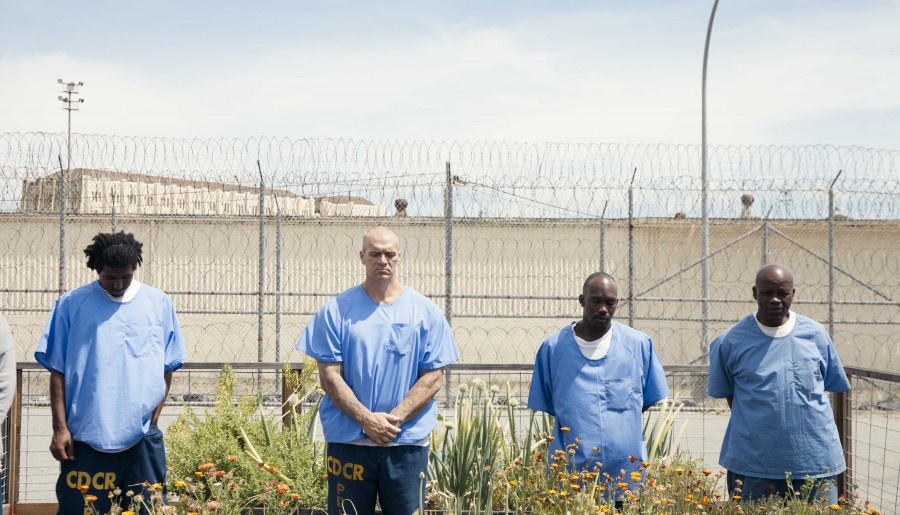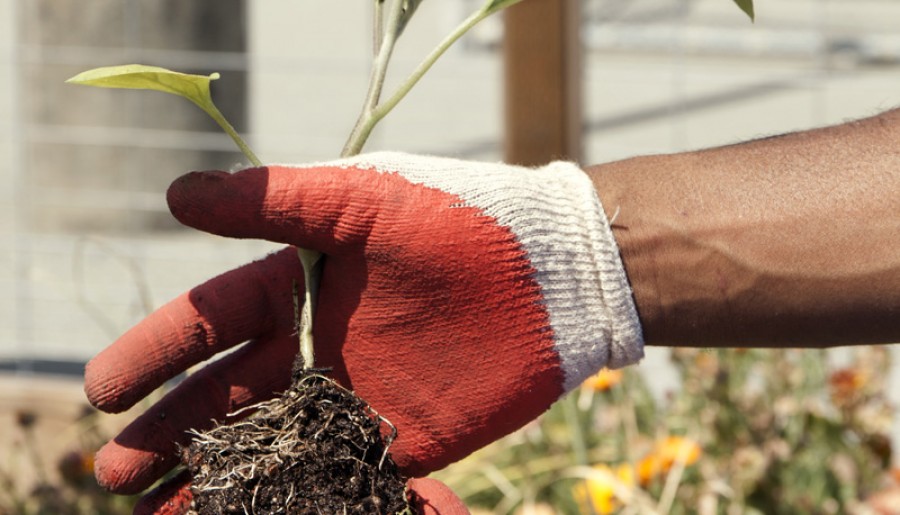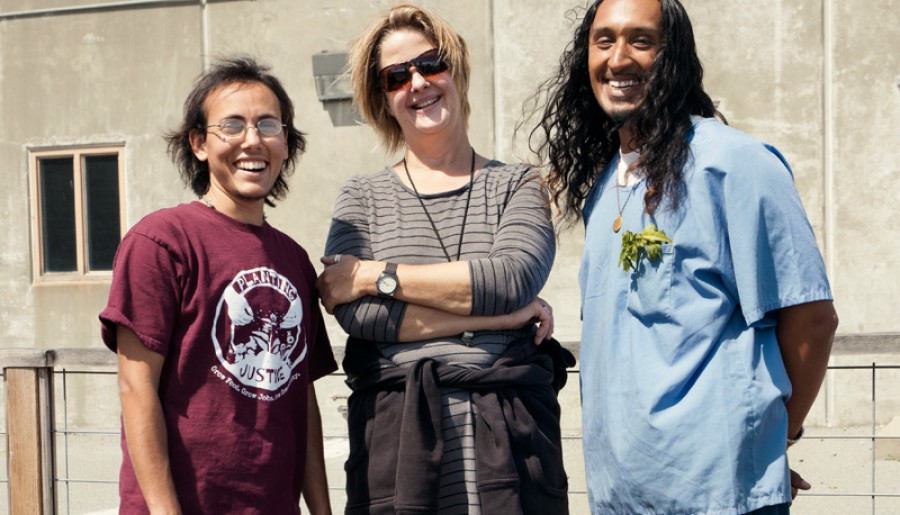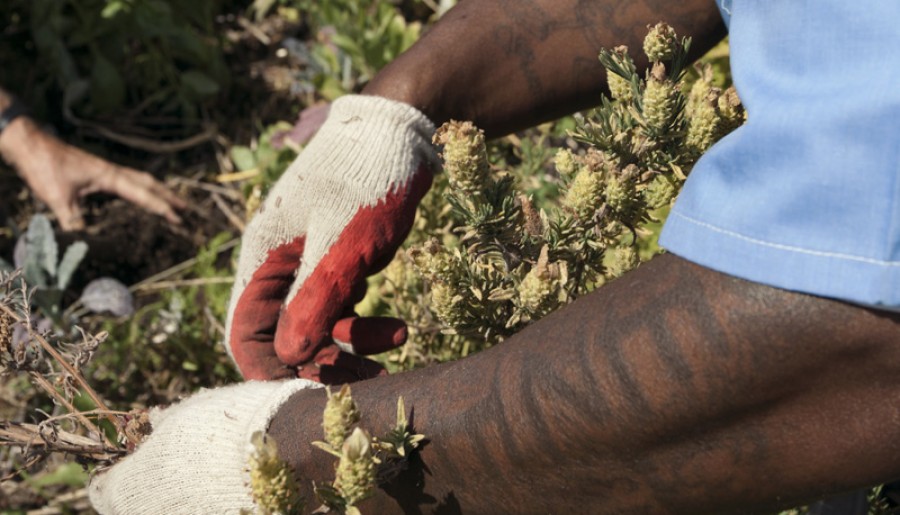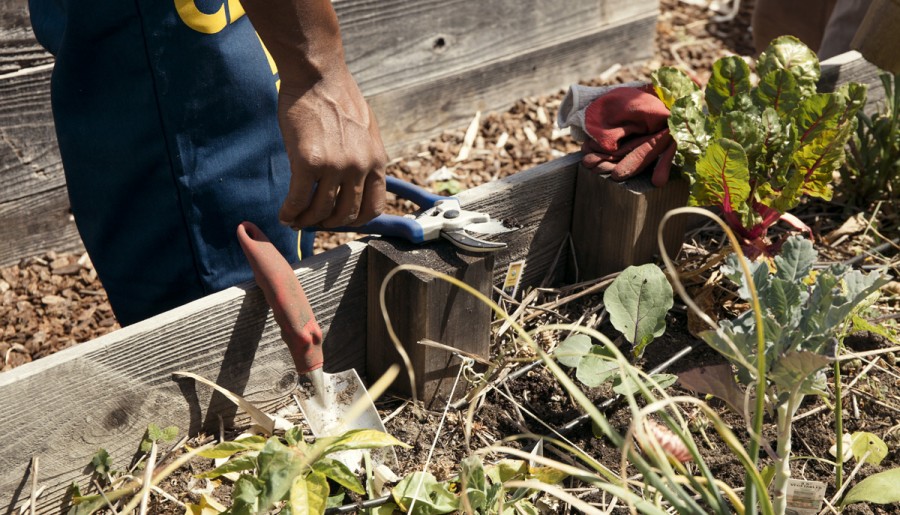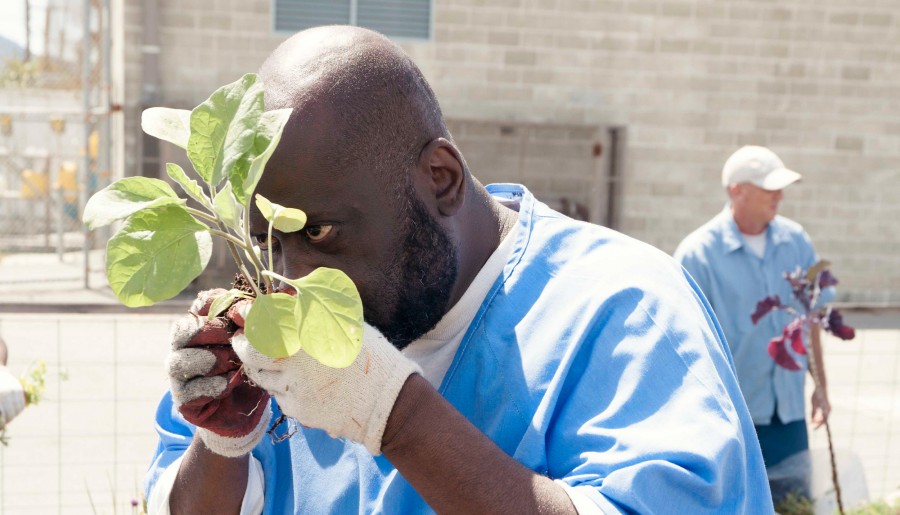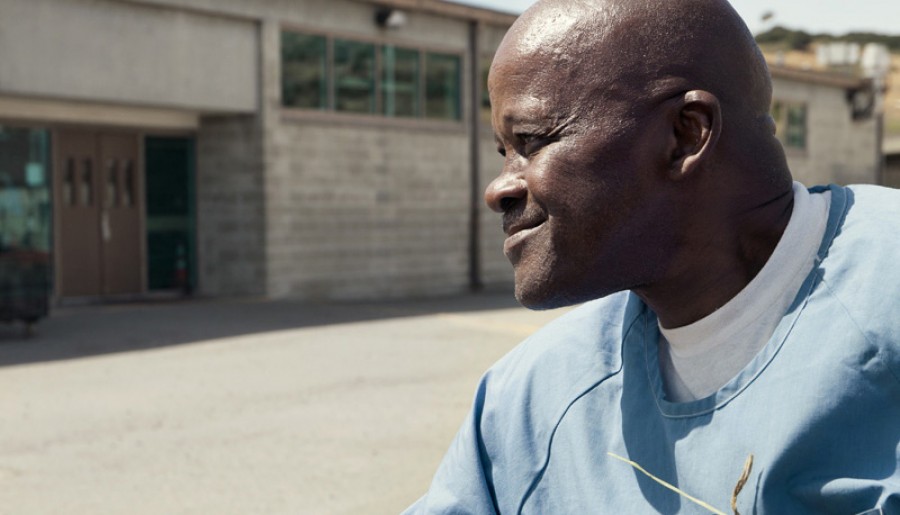Chapter 07
Breaking New Ground
Gardening on the Inside
“I’ve learned in this program that we are all really connected; the minerals that are in the soil are the same minerals that are in us. It’s a relationship between us and the plants. We need each other to be able to survive.”
Darrel, Insight Garden Program participant
The H-Unit at San Quentin State Prison just north of San Francisco houses inmates serving sentences under 15 years. Enclosed in a far corner of the barren blacktop expanse sit four raised beds of greens, herbs and ornamental plants. At this green oasis, men enrolled in the Insight Garden Program (IGP) are offered the opportunity to re-envision their lives as fertile ground. Here, inmates dig the soil, plant seeds, pull weeds and spread mulch. Along with this vocational training, they’re also introduced to holistic practices like mindfulness meditation and systems thinking. This unique approach helps inmates connect to self, nature and community, providing a foundation for a healthier life while in prison and after release.
Over the past 12 years, this class—which meets just once a week—has had an oversize impact on its 1000 participants. Surprisingly, the program’s benefits have little to do with eating what is grown here, since every vegetable and herb is donated to local nonprofits. Rather, through taking responsibility for planting, tending and harvesting the garden, prisoners learn to take responsibility for their own lives.
“The guys in the program have so many Aha! moments when they learn how growing food and creating gardens can be a solution for healing many systems: social systems, food systems and environmental systems.”
IGP Director Beth Waitkus explains that facilitating an understanding of gardening and eco-principles opens the men to insight and a deeper understanding of interdependence. “The guys in the program have so many Aha! moments when they learn how growing food and creating gardens can be a solution for healing many systems: social systems, food systems and environmental systems,” she says. But these outer-world issues mirror important inner issues, which are addressed through IGP’s inclusion of mindfulness practices. “They start to cultivate strategies for living as they begin to see their lives as a garden that they can tend,” she says.
Skye, a ponytailed man in his late thirties, clearly articulates the connection: “The gardening metaphor is using the example of nature to correct misguided principles that we have entertained as misguided men. So for example, we have things like weeding that we do regularly, right? But we didn’t do that in our own personal lives, a lot of us—and weeding is essential.
“When you have things that are obstructing your ability to grow, it might be a good idea to consider purging that from your figurative garden.”
Charles, an older African American man, calls himself a “repeater” because he’s served multiple sentences. He had worked as a landscape designer before he spent time in prison, so the garden is a familiar spot for him. But his previous training only went so far. It’s IGP’s ability to connect gardening with inner change that has been the most helpful for him. “Plants need the same care and attention that we need to give ourselves and each other,” he says.
Waitkus has seen how Charles—and other inmates—work with their emotional reactions in the garden, learning to do what’s needed instead of acting on their own impulses: “Charles hates to have the plants pruned, which we do in the early spring,” she says. “Even though he’s resistant to it, he knows it has to be done for the benefit of the plant.”
Other lessons are more subtle but just as powerful. Peace, beauty and even freedom seem to grow through the gardening program. “There’s such a quietness here where you can hear your thoughts,” says Charles.
Azraal, whose towering figure has earned him the nickname “Big Az,” also appreciates the tranquility and the freedom he finds in the garden. “When I was transferred to this unit, I was drawn to the garden,” he says. Azraal admitted that he hadn’t touched a tree in 12 years up to that point; his connection to nature had been completely severed while serving time, until he joined the Insight Garden Program.
“Being out in the garden brings back memories of my childhood, when my step-mom used to grow vegetables,” he says. “It’s a bit of freedom. All the constraints and stressors of the routine here are gone. It’s fun to get our hands in the dirt, smell the flowers, hear the buzzing of a bee. That’s something that we all need to thrive, and to feel alive.”
What stays with him when he goes back inside—to the chow hall, to his barracks, to the barren surrounding yard—is that sense of growth that he is now connected to. A model of positive rehabilitation, Azraal has learned through the IGP to take responsibility for his impact on the community. “I steered myself in a negative way, driven by anger and hatred and feelings of animosity,” he says, describing the years he’s spent in prison for acts that he now deeply regrets. “I decided to look at the beauty instead.”
The Seed
Waitkus began developing ideas for IGP after the attacks of September 11, 2001, when she, like many others, began reassessing her life. “I had been working as a communications and organizational consultant,” she explains. “But was this really the legacy I wanted to leave to the world?” A series of introductions took her to San Quentin, located just miles from her house in Marin County, where she was inspired by Jacques Verduin, founder of the Insight Prison Project, who was bringing his own mindfulness-based programming to the prison. She thought she might be able to add to Verduin’s efforts by creating a green space for inmates.
As a lifelong gardener, Waitkus was deeply impacted by the desolate and depressing physical environment at San Quentin and had the hope that she could “grow gardens to heal lives.” She knew that many institutions, from hospitals and rehabilitation centers to retirement homes, used gardening—or, horticultural therapy—to help with the physical and mental health of residents.1 In 2003, Waitkus broke ground on a garden plot in San Quentin with the help of a committed group of prisoners.
Despite so much land and labor available at prisons, gardens are extremely rare, and difficult to establish.
It had taken Waitkus a full year to gain permissions from San Quentin to create a small flower garden, assemble a team of volunteers, design a garden curriculum, and create the organization. Permissions for a second, larger garden took five years to secure. Waitkus calls the process “an enormous struggle” that involved multiple stakeholders coming together against the odds.
Over the last decade the garden program has become a fixture in San Quentin’s rehabilitation courses and has proven to be a successful measure to reduce recidivism. A 2011 tally of 117 garden program participants who were paroled between 2003 and 2009 found that less than 10% returned to prison or jail. Waitkus estimates that this saved California taxpayers around $54M. In California—the state with the most incarcerated individuals in the country—the rate of re-offense is remarkably high. Currently, there are 112,300 inmates doing time, with 13,500 released every month. But 61% of these former inmates return to prison within three years.23
And a study at Riker’s Island in New York City, home of one of the country’s largest prison gardening programs, found re-conviction of garden participants to be over 10 percent lower than state and country averages and lower still compared to other Riker’s Island inmates.4
Too many individuals from our country’s prisons are released without the skills or connections to find jobs, housing and community. They default to their previous criminal behavior until something breaks their cycle of crime and incarceration. The Insight Garden Program, with its combination of mindfulness and vocational training, offers both personal transformation and a path for successful reentry.
The Elements
Exposure to nature is crucial for human development, and also for building up the capacity for empathy.
How can gardening prove to be so effective for furthering rehabilitation? Studies in biophilia, which hypothesizes an innate and meaningful connection between human beings and nature, are showing that exposure to nature is crucial for human development, and also for building up the capacity for empathy.5 Horticultural therapy is a well-documented path to reduce stress and anxiety and promote both physical healing and psychological well-being.
The garden’s benefits to well-being are intuitive, but how does the IGP contribute to reduced recidivism? Planning and taking care of a garden has been shown to improve cognitive functioning—to the degree of even reducing the risk of dementia in older individuals. Some of the tasks associated with gardening—such as planning the garden, planting the seeds, caring for the soil—can stimulate the area of the brain responsible for executive functioning. Through gardening, inmates can improve their capacity for planning and problem solving, assessing consequences of one’s actions, regulating emotions and increasing self-control.
And gardening can increase confidence, allowing people who may not have a lot of skills or education to see success quickly in their work. Seeds sprout, flowers bloom, and buds soon become food. For inmates—especially repeat offenders who can’t break out of a destructive pattern—successfully fostering this cycle of life builds up their self-esteem, which has often been damaged by early childhood trauma as well as by incarceration itself. And the practicality of learning new skills empowers the inmates in their own learning process, further increasing their confidence.6
Over four semesters, the program follows a curriculum aligned with the seasons. In the winter, the men study systems thinking and ecological principles, learn how food is produced and consumed in today’s economy, and study food systems’ impact on climate change.
In the spring, they tackle more specifics about gardening and plant biology, and build their vocational skills with mulching, pruning, planting, weeding and watering.
Summer is their season for cultivating their own “inner gardens” and building up emotional intelligence through basic meditation and mindfulness training. One practice session, for example, includes reading a poem with vivid images of nature followed by guided meditation that helps inmates turn from personal thoughts and concerns to peaceful and nurturing impressions of sunlight, flowers, cool grass and other natural elements.
“Cultivating mindfulness is like cultivating a garden," says Waitkus.
Such practices help the inmates become capable of internalizing the peace and calm of nature and returning to that experience even under stress. “When we tend to the breath or follow guided imagery, thoughts that no longer serve us can slip away … allowing our ‘inner garden’ to flourish.”
The fall term focuses on preparing the men for their release and re-entry into their communities. “We are addressing how to support yourself: how to eat healthier food, how to develop those life skills that can be translated into green jobs or entrepreneurship,” says Waitkus. “We talk about values and accountability and commitment, because these are essential elements for people living on the inside who return to our communities.”
Together, these program elements help inmates relate their work in the garden with life beyond their own immediate needs. Reginald, an IGP participant, said he’d never studied ecology before and it was a revelation to realize that he was in a reciprocal, cooperative exchange with the environment. “[Plants] give me oxygen, and I give them carbon dioxide. We need each other,” he explains.
Caring for the garden during a record drought in California has also given him a newfound appreciation for water. The men have devised a system for capturing greywater from the sinks in the chow hall to use on the garden, which saves gallons and gallons of freshwater. “Nothing’s wasted in nature,” Reginald explains. One material just transforms into another, and the cycle goes on.
Darrel, another IGP participant, explained that his previous mindset was about just trying to survive and make enough money to support his family. But now he is oriented towards his values, which include a passion for environmental issues. “Before I started this program, I really didn’t care about gardening … or what needs to happen in order for this planet to be sustained,” he says. “It’s opened my eyes to a different way of thinking, like if everyone doesn’t come together to protect the Earth now … I’m trying to encourage a lot of people I know, like my kids. I’m trying to start my kids off in planting.”
Beyond the Garden
Unlike many prison-based rehabilitation programs, the Insight Garden Program connects inmates with job opportunities upon release. IGP began partnering with Planting Justice, a nonprofit food justice organization based in Oakland, in 2008. Planting Justice staff work with the inmates in the garden, teaching them skills and reinforcing the objectives of the curriculum. Then they train and employ IGP graduates to build edible permaculture gardens for $17.50/hour in the Bay Area once they are released.
“Planting Justice is a direct pathway to living wage jobs,” says Gavin Raders, Executive Director. The organization has placed 17 men in jobs and also teams up with five other community organizations to provide connections to housing and social services. “You not only need a job when you get out,” he explains; “when you have a lack of social services, that directly contributes to high recidivism rates and violence.” So far, Planting Justice has not seen a single employee return to prison.
Waitkus says that she has had interest from many other prisons across the country that want to set up garden programs. She began working at the California State Prison in Solano in 2013. Her program, which received a grant to support a small core staff, has also recently received funding from the California Department of Corrections and Rehabilitation to expand to two additional state prisons. On top of these four California facilities, Waitkus and her team are launching the curriculum in Indiana and New York state.
“We are doing this work from the ground up, but it has had a systemic impact and created a ripple effect all the way to the state legislature, which helped us expand our programs.”
“A culture shift has been happening,” Waitkus says. “We are doing this work from the ground up, but it has had a systemic impact and created a ripple effect all the way to the state legislature, which helped us expand our programs. It becomes evident that this is one of the solutions to stopping the cycle of mass incarceration.”
Inmates working with Waitkus learn a lot about cycles—cycles of incarceration, cycles of behavior, and cycles of time. Together, they work to ground their experience in the garden with a lived philosophy that can support their life beyond bars. As Skye explains: “Life springs forth and life recedes. We do what we can while the life is there to nurture it, water it, feed it, and then the seasons change. Things come and go. And that’s the nature of living.”
